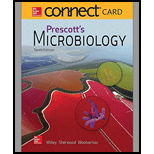
Describe a typhoid carrier. How does one become a carrier?
To describe: The typoid carrier.
Introduction: Salmonella typhi, a gram-negative bacterium, is the causative agent of typhoid fever. In the developing world, typhoid remains a serious health threat, particularly for children. Typhoid fever transmitted from person-to-person through contaminated water and food or by means of close contact with an infected person. Common signs and symptoms of typhoid include high fever, abdominal pain, headache, and either diarrhea or constipation.
Explanation of Solution
Typhoid carrier is defined as a person who remains to shed Salmonella typhi in their feces or urine even though they are asymptomatic. In general, the pathogenic bacteria reside in the small intestine. Subsequently, they may penetrate the epithelium and transmit to lymphoid tissue, liver, gallbladder, and blood.
To describe: That how an individual becomes typoid carrier.
Explanation of Solution
The individual infected with typhoid usually stop shedding the infectious bacteria for prolonged periods. However, some individual may continue to shed the organism in their gallbladder followed by the intestine and the bile duct. This is the mechanism by which one becomes a carrier.
Mary Mallon (Typhoid Marry) was an American cook. In New York City, Mallon employed as a cook in seven homes, between 1896 and 1906. Twenty-eight cases of typhoid fever happened while she worked with them. The Health Department of New York City arrested Mallon and admitted in a hospital, where she kept isolated. Her stool examination report reveals that she was shedding typhoid bacteria in large numbers without any symptoms. Finally, the Journal of the American Medical Association denoted to Mallon as “Typhoid Mary,”. Mallon was kept in custody upto 23 years until she died (1938). Mary Mallon linked probably with ten outbreaks of typhoid fever, 53 cases, and 3 deaths, as a life-time carrier.
Want to see more full solutions like this?
Chapter 39 Solutions
Connect Access Card for Microbiology
